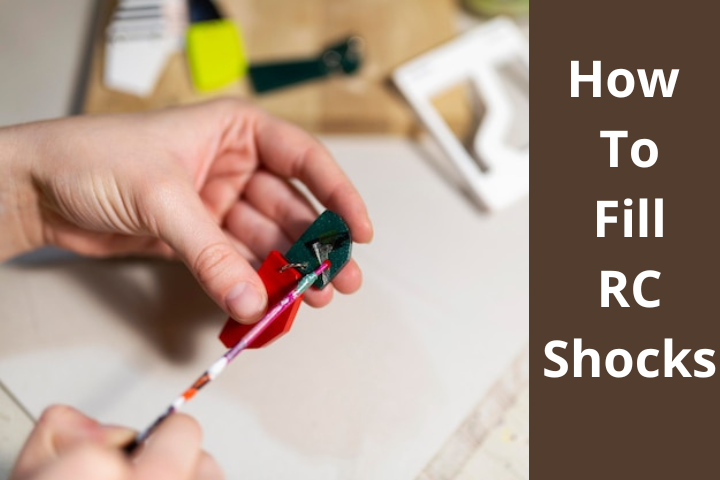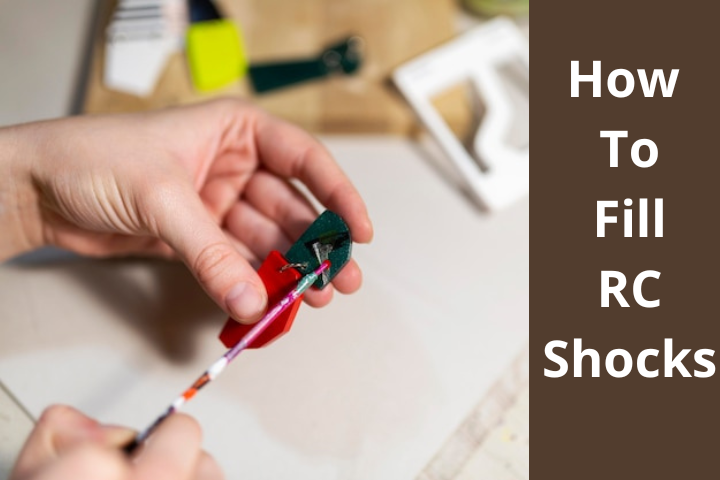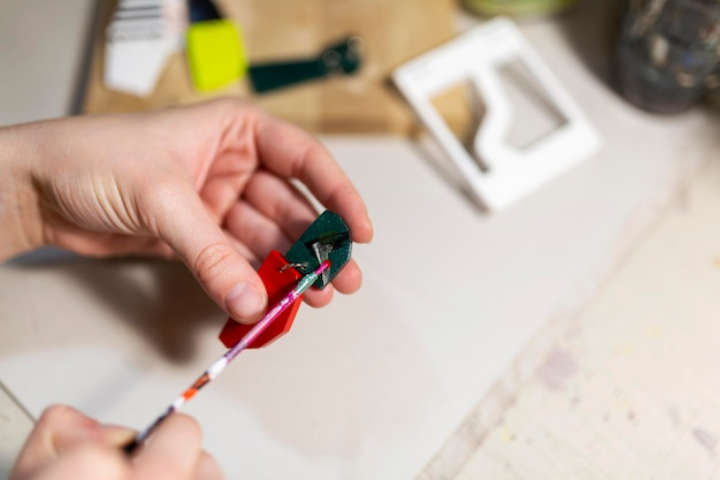
How To Fill RC Shocks? RC car shocks are designed to offer superior handling and control. They provide a dampening effect on the chassis, helping you navigate difficult terrain with ease and confidence. Recent advancements in RC car shock technology have allowed for increased durability while maintaining an overall lightweight build. Experienced RC racers will often leverage these powerful shocks to gain an edge on the track; they know that having the right suspension setup can make all the difference in a competitive setting. If you’re serious about racing, investing in quality shocks should be one of your top priorities.
How to Fill RC Shocks
To fill RC shocks, you will need some shock oil, a shock-fill bottle or syringe, and a way to measure the oil level (such as a dropper or ruler). Here are the general steps to follow:
Remove the shock from the vehicle.
Filling the shocks to your RC car is one of the most important steps to make sure it’s up to its full potential. Without it, your car will be bouncy and not as responsive to control. It’s also important to make sure you use the correct fluid for your shocks; regular oil won’t do the trick! The good news is it is a relatively simple process to fill up your RC shock with the proper fluid. First, pour some of the specialized shock oil into a measuring cup to approximate how much needs to go into each one. Be sure to wear gloves and protective eyewear in case of any spills or splashes. Then, unscrew the shock cap to access where you need to fill it up. Once everything has been filled, close off the shock caps and then adjust accordingly based on your driving needs and terrain type to ensure they’re delivering maximum performance out on the track.
Unscrew the shock cap and remove the piston and spring.
Working on RC shocks to get the perfect setup can often be a daunting challenge, but with the right procedures, it doesn’t have to be. The first step to fill shocks is to unscrew the shock cap to remove both the spring and piston. Doing this is essential to further customize your shock to your track conditions, as this is where all of the adjustments will be made and implemented. If you want to get the most out of your RC car, it is important to understand how to properly dismantle and fill your shocks for optimized performance.
Measure the amount of oil that is currently in the shock.
Checking to make sure the amount of oil in your RC shock is an easy but important task to keep your model running properly. Before you fill the shock, use a shock pump to measure the current amount of oil to prevent overfilling. An overfilled shock will lead to lower performance levels and cost more time to set up for a smoother ride. To accurately measure the amount of oil, hold the body of shock upside down to ensure that no bubbles are forming, and take a few measurements until you get the same result twice in a row to be certain. After taking this measurement, fill or add oil to match your desired performance. This process will ensure that each run your model makes is enjoyable whether it’s on grass, concrete or bumpy surfaces.
Use the shock fill bottle or syringe to add the appropriate amount of shock oil to the shock.
To fill RC shocks, the shock fill bottle or syringe is the perfect tool to ensure precision. These tools allow you to add the exact amount of shock oil to the shock, adjusting to fit different pressures to better suit your desired application. Striking a balance between thick and thin oils can be painstaking without this accurate process, but with the shock fill bottle or syringe the work is done quickly and efficiently. The right oil will make all the difference in completing a successful job.
Replace the piston and spring, and screw the shock cap back on.
Replacing the piston and spring to fill RC shocks is easy to do. All you’ll need to do is unscrew the shock cap to pull those particular pieces out, and then replace it with a shock piston, spring, and cap of your choice. After replacing them, you simply need to screw the shock cap back on to have your RC filled to its greatest capacity! Plus, it’s not just limited to simply pre-filled models, you can customize each shock to create an even greater driving experience for yourself or your loved one.
Reinstall the shock on the vehicle and test for proper operation.
To properly fill an RC Shock, one must reinstall the shock to the vehicle to test and make sure that it is in proper operating condition. First, one should make sure to identify the right preload on the spring and adjust any spacers to ensure a proper fit. Once installed, place the vehicle onto a hard surface to aid with testing and to try different settings. Afterward, check for any leaks or oil seeping out and inspect for any worn-out parts or broken clips. Lastly, test to make sure that it functions as expected, such as delivering optimal ride comfort, handling ability, and responsiveness to driver input.
It is important to use the correct weight and type of oil for your specific shocks and to follow the manufacturer’s recommendations for filling and maintenance. It’s also good to have proper tools for the job and do it in a clean area.
Reasons to Fill RC Shocks
There are several reasons why you may need to fill your RC shocks:
To Adjust the Shock’s Performance
Filling shocks are a great way to adjust the performance of your RC car or truck. This can be done easily; fill shock absorbers with oil that is compatible with the type of shock used. With thicker oil, you will get a firmer ride and it should be used in rough terrain as it offers greater control and resistance to compression. Using thinner oils will give you a smoother ride and provide greater braking stability. When filling shocks correctly, you need to make sure enough oil is in the shock body so that the shaft seal is properly sealed which helps prevent shock fade from occurring. Additionally, refilling periodically (if necessary) keeps both rebounds and dampening consistent throughout the race. By adjusting the amount of oil in the shock, you can change the stiffness or dampening of the shock. This can be useful for tuning the handling of your RC vehicle to suit your preferences or to adapt to different types of terrain.
To Replace Lost or Leaked Oil
Replacing oil in RC vehicle shocks is an important part of routine maintenance for any hobbyist. Most RC vehicles come with metal, aluminum, or plastic shock bodies that need to be carefully filled with a specific oil to prevent excess wear and tear on the springs and other components. In addition to regularly checking for lost or leaked oil that needs replacing, it’s also essential to use an accurate method to fill RC shocks to the correct capacity so they consistently deliver optimal performance. By attending to these essential details, hobbyists can maximize the life of their shocks and reduce downtime due to repeated maintenance than doesn’t adhere to these important standards. Over time, the oil in the shocks may leak out or be lost through normal use. This can cause the shocks to lose their performance and can lead to damage to the shocks or other parts of the vehicle.
To Fix a Damaged Shock
Filling RC shocks is a great way to revive an otherwise damaged shock. The process is relatively simple and all you need is the correct type of shock-friendly oil and a few basic tools such as pliers, wire cutters, and a sealant and solvent cleaner. Taking the shock apart first by removing any screws and then disconnecting the internal parts should be done with care. Adding small quantities of oil one at a time until it reaches the desired level is the next step while taking care not to overfill it. After filling, re-assemble by reconnecting parts in reverse order from disassembly, making sure to lubricate them with some spare oil if necessary. Afterward, check for any leaks around O-rings or other seals before use for safety reasons. If a shock is damaged, it may need to be refilled to repair it. For example, if the shock is leaking oil, it will need to be refilled to seal the leak.
To Maintain the Shocks
With some basic maintenance, you can keep your RC shocks functioning properly. By regularly filling the shock bodies with shock oil, you are immediately increasing the longevity and performance of your ride. This simple step prepares the shocks for more intense terrain and will ensure that they do not become overly worked or stressed more quickly than necessary. The type of oil used highly depends on one’s personal preference, though heavier weights are recommended for spring rates under 1.2 for more responsiveness and stability. When filling the shocks, be sure to add a little extra to lubricate internal components, and then consider exiting the track after 10 minutes to allow the new shock oil to settle into its home. Keeping your RC shocks filled and ready isn’t hard – but it is essential. Regularly checking and refilling the shocks will help ensure that they are in good working condition and will prolong the life of the shocks and the overall vehicle.
The Need for Shocks in RC Cars
In RC cars, shocks are an essential component because of the significant impact they have on the vehicle’s maneuverability as well as its overall performance. They contribute to the car’s ability to absorb and dampen the impact of the bumps and obstacles that it encounters while driving on the track or off-road.
It is imperative to keep the tires of the vehicle in contact with the ground at all times to preserve traction and stability, and the shocks aid to do this. Without shock absorbers, the vehicle would be prone to bouncing and sliding all over the place, which would make it impossible to manage and would bring the vehicle’s speed and performance down.
Shocks, in addition to increasing the car’s handling and stability, also serve to protect the vehicle’s other components from damage. This is an additional benefit of having shocks. The car’s shock absorbers lessen the effect of bumps and barriers as the vehicle travels over them, protecting the vehicle from any potential damage.
Shocks have several vital functions, one of the most important of which is the capacity to be adjusted for different kinds of terrain and driving styles. Different types of oil, different spring rates, different lengths, and different sizes will provide different levels of performance. Because of this, it is essential to have the appropriate type of shocks for your particular RC car and to make any necessary adjustments to them for the various types of terrain and driving conditions you may encounter.
In general, shocks are a key part of any radio-controlled automobile, and they must be properly maintained to achieve peak performance and safeguard the vehicle from being damaged.
Also Read: How To Start Nitro RC without Glow Plug Igniter
Conclusion
RC car shocks are essential components in any RC cars, taking the force of the terrain and helping maintain the grip of your car’s tires while driving. Without them, the unevenness of a rough track can detach you from tight turns, putting a damper on your racing experience. Innovations such as oil-filled aluminum body dampers help increase durability and performance, reducing stress on surface shocks by channeling enough power to your car’s wheels when needed. With modern technology pushing the boundaries of suspension, it has become increasingly easier to make sure drivers have a smooth ride.


